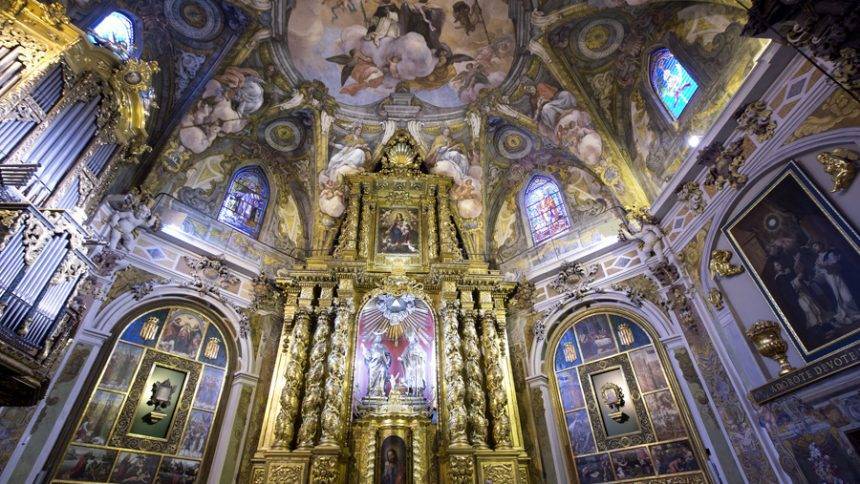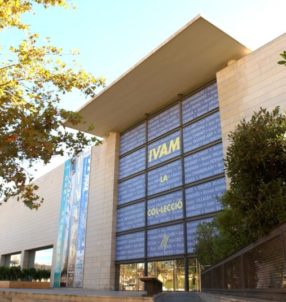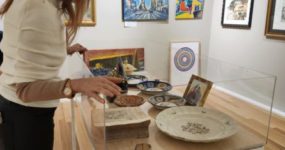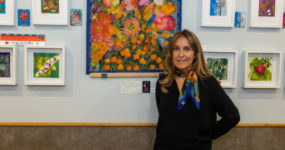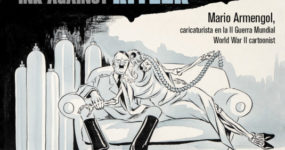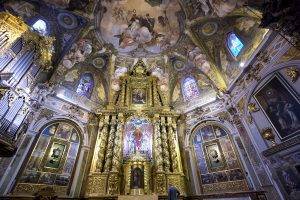
Parroquia de San Andres (Foto: AVAN // Alberto Sáiz)
BAROQUE TREASURES IN THE HEART OF THE CARMEN
Hidden at the end of a little passage way marked “Parroquia de San Nicolas”, about halfway down the Calle Caballeros amongst the tourist trap bars and “authentic “ bodegas, is one of the city’s greatest art treasures. The dazzling Baroque frescoes at the Church of San Nicolas have recently been restored to their former glory and are now open to the public. This was the Borgia’s local church, their Valencia residence was just down the street, and Lucrecia and family had many strong connections with the place.
The original church was built in 1238, one of 12 churches in the city built on the site of Muslim mosques, under the orders of the conquering king Jaume I, to show who was now in charge after he’d retaken the city from the Moors.
The church was in a prime location. A palace in Calle Caballeros was a must for any self-respecting Medieval Valencian noble family. It followed the old Roman Decumanus Maximus road from East to West across the ancient Roman city. Like in the present day Barrio Carmen, it was the only wide straight avenue amongst the surrounding winding maze of streets of the Moorish city. The Borgia family had two houses along the street, which are still standing at number 36 and number 33. This is where the “femme fatale” of the Borgia family Lucrecia (or Lucrezia) lived. They also had a little place off the Calle Navellos, which is big and grand enough to now house the Valencian parliament.
Alfonso de Borgia, the first Borgia pope (Callixtus III) was baptised here by Valencia’s patron Saint Vicente Ferrer. After the ceremony, San Vicente, never one to shy away from finding favour with Valencia’s aristocratic families, made the “miraculous prediction” (or perhaps one of the heaviest hints in history) that “this boy will be Pope and he’ll make me a saint”. He obviously knew a thing or two as Alfonso eventually became Pope and fast-tracked fellow-Valencian Vicente to sainthood in 1455, just a few decades after his death.
Before he went to Rome, Alfonso became rector at San Nicolas and rebuilt the church in Gothic style. San Nicolas Church benefitted greatly from its connection with the family. Rodrigo Borgia (later Pope Alexander VI) was a protector and patron of the church as were his infamous children Lucrecia and Cesar, who made frequent lavish donations to the parish throughout their turbulent lives.
The frescoes now on show date back to the 1690s, when it was decided that the old Gothic church would be refurbished in the new fashionable Baroque style. In response to the Protestant Reformation, the Catholic Church seemed in danger of being seen to be out of touch. The Church decided it needed to get closer to its audience and hit upon baroque art, with its exciting motion and theatrical tension and its clear & easily interpreted detail as the ideal way of putting its message across to Joe Public.
The style quickly spread from Italy across Europe and the decoration of the Church of Saint Nicolas is one of the finest examples in Spain. It’s not to everyone’s taste, if you like the cold & simple stone of a Gothic church you are in for a shock. Part of the attraction of baroque was that it impressed the power of the church on normal folk by making churches look like the lavish palaces of the aristocracy. It’s brash, dramatic, shiny and over-the-top. The frescoes were designed by Antonio Palomino, Carlos II’s court painter (who also did the inside of the Dome of the Basilica in Plaza de la Virgén) and carried out by the Valencian Baroque painter Dionis Vidal.
Once you’ve paid your two euros entrance fee (you can also pay extra for a guided tour) and shown your ticket to a small army of staff who seem to queue up to inspect your ticket at every turn, a breath-taking blaze of colour and expertly crafted detailed images jump out at you from all angles.
The frescoes almost completely cover the walls and high ceiling vaults (they must have had very long paint brushes in those days). The pictures are extremely figurative and dramatic interpretations of biblical stories, allegories, architectural drawings and scenes from the life and miracles of Saint Nicholas. This was Saint Nick’s early period before the red suit and the reindeer but he can be clearly seen in his fulsome bushy beard, not unlike a modern day hipster craft beer pub barman, performing his saintly good deeds. There are also portraits of the artists and of course Alfonso Borgia himself.
We are told in the blurb that San Nicolas is one of the finest examples of baroque art merging perfectly with the previous gothic style, one not overpowering the other, but for some tastes (including ours) it can seem a bit overdone and slightly disorientating. Nevertheless, you can’t deny the sheer beauty, drama and amazing detail (and the historical importance) of the frescoes. And all this on your doorstep just a hop and skip away from the kebab shops and stag parties along the old Calle Caballeros.
David Rhead and José Marín


